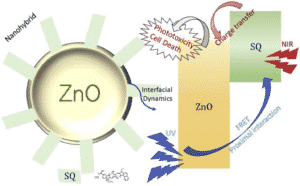D Bagchi, A Halder, S Debnath, P Saha, SK Pal – Journal of Photochemistry and …, 2019
Abstract
Photodynamic therapy (PDT) is a clinically approved, minimally invasive therapeutic procedure exhibiting cytotoxic effects toward malignant cells. Hydrophobic nature of most photosensitizers used in PDT with lower light absorption ability restricts practical use of PDT. Herein, we have employed a squaraine drug (SQ) with 665 nm absorbance peak maxima as the photosensitizing agent and evaluate its photo-physical properties. The tendency of aggregation formation in aqueous media limits its practical usefulness. Thus, we have synthesised wide band gap semiconductor zinc oxide (ZnO) nanoparticles and functionalized the surface using squaraine molecules. The molecular cross-talking was evaluated using excited state fluorescence lifetime decay profiles and by employing Fӧrster resonance energy transfer (FRET) technique. The nanohybrids show improvement in three aspects compared to bare SQ molecule such as lesser aggregate formation in aqueous media, pH responsive precipitation of the drug and improvement of photo-induced reactive oxygen species (ROS) generation. Ultrafast dynamical study at the inorganic (ZnO) – organic (SQ) interface depicts presence of photo-induced charge transfer process at the junction which indeed improves the ROS generation capability. Finally, the photodynamic action has been evaluated in human breast cancer cell line MCF-7. The nanohybrids depict enhanced photo toxicity in cancer cell with loss of adherence and typical morphology of cancerous cell depicting controlled cell death. The present study employ characterisation of nanohybrids for potential use in PDT for cancer treatment.

… The peak maximum of red LED is at 640 nm with 3 mW/cm 2 intensity. The penetrating effects of white light were determined using a tungsten-halogen light source (400-1200nm) and the transmitted spectral response is determined using StellarNet Inc spectrograph …





